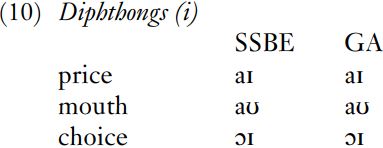
Monophthongs and diphthongs
 المؤلف:
April Mc Mahon
المؤلف:
April Mc Mahon
 المصدر:
An introduction of English phonology
المصدر:
An introduction of English phonology
 الجزء والصفحة:
73-6
الجزء والصفحة:
73-6
 18-3-2022
18-3-2022
 1501
1501
Monophthongs and diphthongs
Most of the vowels we have considered so far have been monophthongs, in which the quality of the vowel stays fairly consistent from the beginning of its production to the end. However, there are also several diphthongs in English. Diphthongs change in quality during their production, and are typically transcribed with one starting point, and a quite different end point; as might be expected from this description, diphthongs are typically long vowels. In English, all diphthongs have the first element as longer and more prominent than the second, and are known as falling diphthongs. Three diphthongs are found very generally in accents of English, and are shown in (10).

The long high-mid front and back vowels in face and goat are also characteristically diphthongal in SSBE and GA, as shown in (11).

Finally, SSBE has a third set of diphthongs, which are known as the centring diphthongs as they all have the mid central vowel schwa as the second element. These centring diphthongs developed historically before /r/, which was then lost following vowels in the ancestor of SSBE; they consequently appear mainly where there is an  in the spelling, although they have now been generalized to some other words, like idea.
in the spelling, although they have now been generalized to some other words, like idea.
GA speakers have a diphthong in idea, but still pronounce the historical [ɹ] in near, square, force, cure and therefore lack centring diphthongs in these words (see (12)).

 الاكثر قراءة في Phonology
الاكثر قراءة في Phonology
 اخر الاخبار
اخر الاخبار
اخبار العتبة العباسية المقدسة


